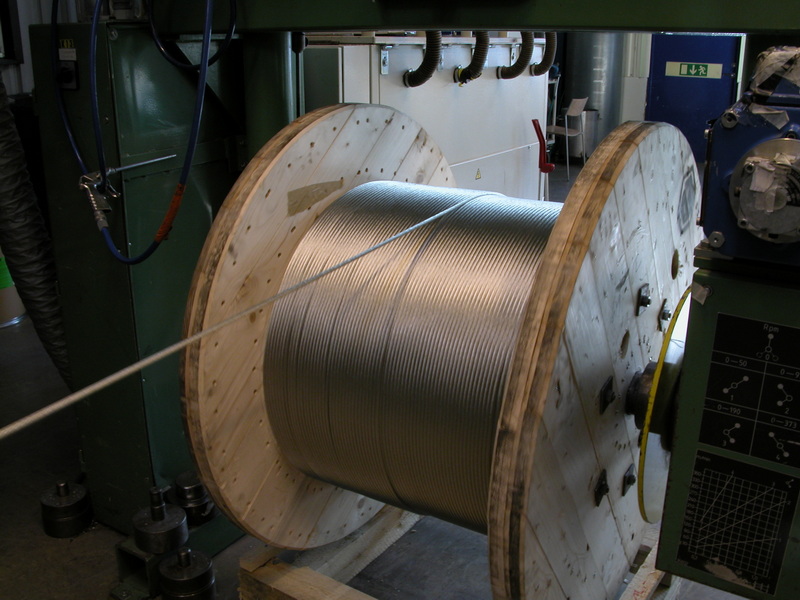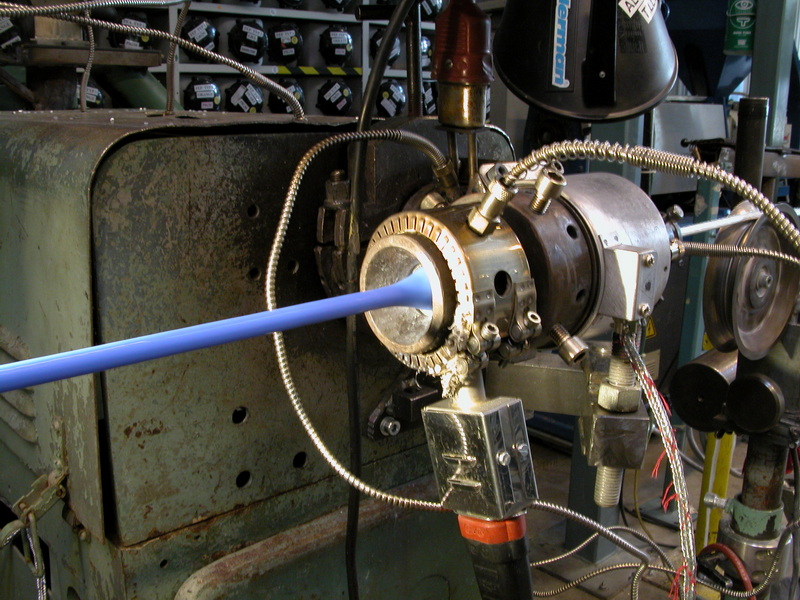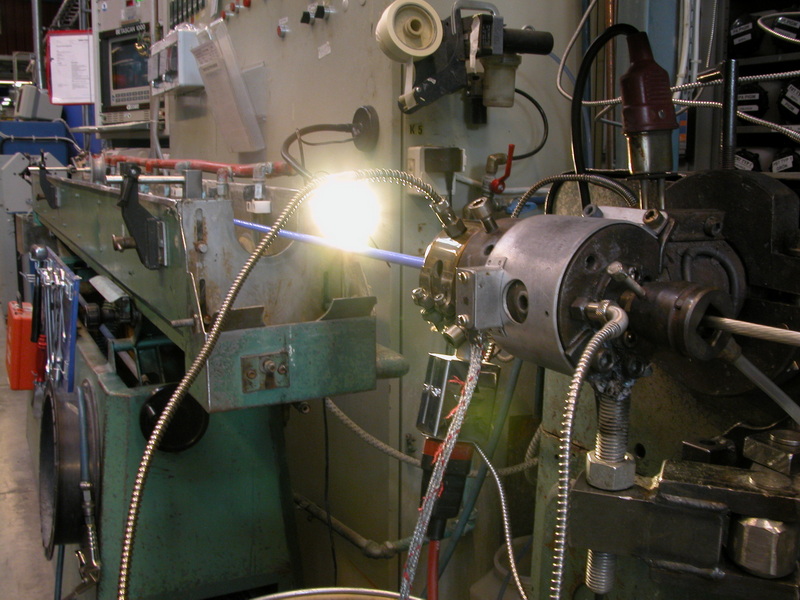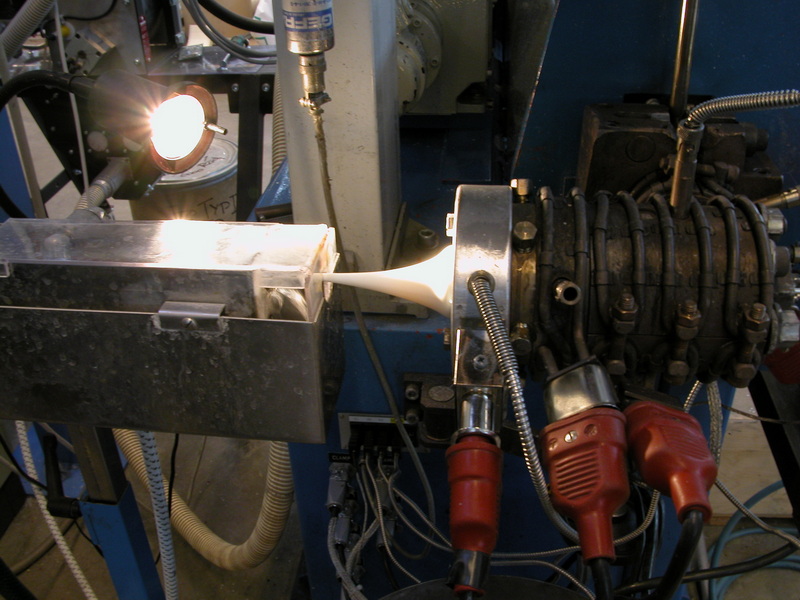THE OPERATION OF POWER CABLES-The article below explains how power cables work and why we believe we observe differences. See the article mainly as a not complete and very concise summary of the extensive knowledge that is available about such cables. The intention is to make consumers think about how power cables work.
Cables for the Joint Strike Fighter
The second reason to focus on power cables was the development of the Joint Strike Fighter (JSF). The undersigned has invested some time in a preliminary investigation for a client in order to be able to develop cables for this aircraft. The procedure is then always that a manufacturer (Lockheed Martin) invites organizations to develop parts for such an aircraft. A company can register for such a tender and then receives a list of requirements. These are the requirements that a product must meet. Whether tires, wing parts, communication equipment or engines. In this case cables.

The list of requirements is extremely strict and extensive. Not what you need for your new table lamp cord. Aircraft parts must meet, among other things, properties in the areas of temperature resistance, flammability, conductivity, mechanical strength, vibration resistance, electrical properties, pressure, safety, gassing, emission, environmental standards and sensitivity to radiation. Then you only talk about a few requirements from a huge package. They then have to meet the so-called milspecs and countless other international standards. Based on all those requirements, you will then determine whether it is indeed possible to develop and build such a cable and whether it is also financially attractive to participate. You also know in advance that you will not be the only supplier. Such an aircraft factory has the same cable built by at least three different suppliers. This applies to all aircraft parts and is intended to avoid delays in series production.
Power cables for hi-fi purposes: questions

Translated to the world of hi-fi, a number of questions have arisen from this. Many high-end systems have a hefty price tag. Composed of speakers, amplifiers and source components designed by manufacturers with a serious background in design, engineering and advanced knowledge. Consider modern computer systems designed loudspeakers, class D technology and modern DA converters. However, the cables we use are not accompanied by evidence of their exact operation and compliance with international standards and measurements. The question is whether some cables already have a basic Kema quality mark. There is little evidence that cables meet specific quality requirements. It is not unreasonable to expect such a thing from products that sometimes cost thousands of euros per meter. Consumers are often critical when it comes to a car or dishwasher. But in the audio, critical discernment often seems distant and misplaced emotion often plays out. Remarkably, when it comes to audio, it seems as if certain parts of the brain are switched off.
Standards for ‘digital’ cables
Cables that meet strict standards do of course exist. They are made for JSF, nuclear power plants and medical applications, among others. But, you hardly come across them in the audio world. Cables for the transport of digital signals in the audio do meet standards. For example, we know standards for USB and HDMI. Once a cable meets such a standard, it is good and almost impossible to get better performance. Even though such a USB cable costs 12 euros. Still, some listeners indicate that they hear differences between ‘digital’ cables. The most obvious explanation is that these differences are caused by the entire domain of disturbances around and in such a cable. Depending on various other factors, the interference can mix with the audio signal and become noticeable.
Analog cables: theoretical model
The question is whether it is possible to develop analogue cables that meet international standards and can deliver a demonstrably better and also descriptive performance in a system. First, the assumption (hypothesis) that it is extremely difficult to design ‘better’ cables is appropriate. What are you going to do exactly? There are generally small differences between interlinks. Slightly larger differences between speaker cables. However, there has never been a cable here that performs a lot better. There is a lot of theory about the optimal architecture of a cable. Whoever builds a cable according to the theory apparently achieves a kind of ceiling in performance. It seems very difficult to get beyond that. Almost every cable manufacturer has a few cables in the catalog that are approaching the theoretical optimum.
Mains cables for hi-fi purposes

Fans of hi-fi cannot be said about mains cables. Characteristic of the (amateur) audio world is that discussions about all kinds of technical subjects have been going on for forty years without ever resulting in a conclusion, synthesis or generally accepted insight. Imagine something like this taking place in physics, space travel or virology. Many audiophiles at least indicate that they hear differences when power cables are exchanged. The question is to what extent this is possible and what it has to do with. In this article it is not possible to understand every aspect of grid cables, but if part of the theory is summarized, there are at least six causes for the differences that grid cables can possibly make.
First, mains cables can generate interference signals themselves and bring them out via radiation or conduction. That can simply be measured. They can also transmit collected radiation (via the air or via conduction) to a greater or lesser extent. The amount and nature of interference can affect the audio signal in the connected equipment. There is a whole theory about how so-called conduction noises (via conduction) find their way to the parts in our audio equipment. It is internationally regulated through CISPR how much conducted noise may be accepted via AC lines (grid cables). How many mains cables have that quality mark? Stronger magnetic fields have been shown to have a negative effect on the signal-to-noise ratio of audiovisual equipment. But most of the interference is generated in audio devices themselves. For example, due to the operation of rectifiers and transformers of the UL type.
The Operations of Power Cables:Psychoacoustics
Second, psychological processes play a role in some audiophiles. In any case, psychoacoustic effects determine how we perceive the sound that is created by mixing the interference with the audio signal. Because a cable is expensive, you will hear things that are not there. The vast majority of audiophiles therefore go for the ax in blind listening tests, including the undersigned. The most beautiful example of this was entrusted to the undersigned long ago by a cable manufacturer. This manufacturer, based somewhere in the world, built cables with a hefty price tag. At that time interlinks and speaker cables, because the consumer market for ‘digital’ cables hardly existed. Those cables were successful and soon there was a demand for power cords. Overcome by this question, this manufacturer, in order to be able to jump into the market at lightning speed, a mains cable built from a few meters of cord from the hardware store and packed in a centimeter thick proverbial garden hose. Simply executed in the chic corporate identity with ditto packaging and an otherworldly price tag. It was a huge success and the customers all thought they saw enormous improvements. In any case, nothing has been heard from this manufacturer for a long time.
Power and shielding

Thirdly, cables with very thin ‘stranded’ cores sometimes cannot pass enough current. Wanted and then it has to be very rough. A single core (solid) copper wire with a diameter of 1.6 mm (surface is 2.1 mm2) already allows 24 A. To achieve 15 A with a stranded wire, the diameter must be 2.6 mm (surface 5.3 mm2). Most mains cables, including those from the hardware store, have enough diameter to allow 16A to pass through. So-called ‘high current cables’ in the hi-fi are nonsensical. If equipment requires more than 16A, the fuse will trip. However, if a wire that is too thin is replaced by a thicker wire, a device that received just too little power can sometimes sound a little better. That is sometimes one reason why any ‘audiophile’ power cord sounds just that little bit better than some supplied power cords.
A fourth reason is that some mains cables have an RFI shield. Narrowband indoor and outdoor RF sources can therefore be blocked and cause less disturbing effects. The RFI influence is usually small. If an RF source radiates around the house, some of the interference will end up in the cable via the electricity grid (conductive), some via radiation (if there is no shielding) and another part possibly directly into the sensitive audio equipment. Such a cable shield against RFI does not always make sense, except in rough conditions. Some mains cables are built as a kind of RF filter for conductive noise. Depending on all kinds of conditions, this can sometimes make a small audible difference.
Electrosmog and EMI
The fifth reason can be found in the article by Ed Doggen (Music Emotion and Daluso website) about electrosmog. If a mains cable produces a lot of ‘smog’, it can change our perception. Well, that will be easy with a single mains cable, but if the hi-fi or theater system has a lot of poorly designed mains cables, a higher dose of electrosmog can occur.

A sixth reason is that some power cables block EMI. EMI is often the main source of interference. It is plausible from the literature that the differences that we think we hear are largely related to the way in which a mains cable ‘behaves’ in the field of disturbances. It is important to realize that a mains cable can never change the sound. For the simple reason that the audio signal does not run through the mains cable. The same goes for cables that carry digital signals. The musical code can never be changed by the cable. Bits are bits. Cables don’t make big differences either. If your new cable really makes an impressive difference to the previous model from the manufacturer, then you really have to wonder what you bought at the time, or what is going terribly wrong.
The general experience of listeners is that mains cables make little difference. That’s right. A majority of the grid cables do not demonstrably have a design that does anything to stop faults (to a sufficient extent) or not to generate them themselves. There are different standards in the world that regulate protection against EMI. The CE also contains the so-called EMC directive (EN 50081-2: 1993). Have you ever seen cables with a quality mark that guarantees EMC? They do exist, but not within the audio world.
Enemies

Consumers often rightly wonder what influence a piece of cable of a meter can have on the performance of, for example, the connected amplifier. To understand this, it is necessary to look at mains cables in a completely different way. Mains cables are rarely a solution to a problem, but they are mainly the causes. Without power cables, our audio would perform much better. Think about battery power. A better mains cable is the one that causes fewer problems. If you are a goalkeeper in a football team and your defenders and the attacking side are far from your goal, then you have no problem. However, when the attacking side and your own defenders come close, trouble begins. The attackers cause disruptions. Your defenders often let those disturbances through, but are also a source of interference themselves, because they sometimes shoot at their own goal. A net cable (attacker and defender) works exactly the same way. The keeper, who himself is also a source of disturbances, then eventually has to deal with the disturbances and is comparable to an amplifier. The problem arises, just like in football, mainly because the attackers and defenders are close to the goal.
A mains cable is very close to the place where damage can be caused by those faults. That’s one reason why that ‘last meter’ can make a difference. Such a mains cable is very close to the equipment and other cables can simply be ‘sprayed dirty’. Or not, if the design is good. Because mains cables are available that are not built entirely according to the book, a consumer is more likely to bring the problems into their home than to have them solved. Any improvement that an audiophile network cable brings is mainly due to the fact that that cable causes just a little less interference. A mains cable must meet certain requirements. Less disturbances will be pumped into the audio equipment and the sound will often sound a bit better.
How does it work then?

The current that flows through a mains cable generates a magnetic field. That field then generates a current in wires that are nearby (source: 2019 IEEE Conference of Russian Young Researchers in Electrical and Electronic Engineering). This has been demonstrated by measurement in the aforementioned article. So, if the mains cables are in the vicinity of the interlinks… .., but a voltage can also be generated in the groundwire of the mains cable itself, which ends up in the connected audio equipment. This mechanism arises when the architecture of a mains cable is faulty. Then there may also be electromagnetic fields near such a mains cable. For example due to the presence of transformers. From that transformer a current can then be generated in that mains cable. Yes, but this mains cable is completely shielded, the cable manufacturer will then call. The problem is that cables in the audio world are generally much less or not shielded against EMI (disturbances caused by electromagnetic radiation). The shielding that may be present in mains cables usually only works for RFI.
What also happens is that many mains cables simply transmit the interference signals that ‘come along’ from outside to the connected electronics. These are usually few failures that come in from outside via the electricity grid. The interference signals that may be found on the socket come mostly from sources in the house. For example from electromagnetic fields or RF signals generated by household appliances. What could come from outside are high-frequency narrowband interference signals from radio transmitters. RFI generally does not couple as quickly with the audio signal. However, there is also a standard for the maximum interference voltage that may be on the wall socket over a large frequency range. In general, that means, regardless of that known exception, that you as a consumer are the main cause of interference signals as a result of what is in the house. These disturbances end up somewhere in the signal path via that exotic network cable.
The ultimate power cable

EMC (electro-magnetic compatibility) means, among other things, that an electronic product does not interfere with other electronic systems. A lot of equipment, especially in the professional world of networks and communication, has to meet this compatibility requirement. Have you ever seen a cable manufacturer claiming that its mains cables fully meet the EMC requirements? These cannot be found in audioland. Coaxial cables for your DA converter or streamer should comply with Screening Class A, in the IEC 61196-6 standard, for attenuation of incoming EMI alone. A design document has been published in the UK containing techniques that can be used to make cables that meet the EMC requirements. A note in the document is that almost all cables are just antennas. They suck everything up from the outside and dump it just as hard in the signal path of sensitive audio equipment. With the purchase of many audio cables you often get the Trojan horse.
The next question is of course whether it is possible to build cables that meet the EMC guidelines and what such a cable will look like. Well, that is a complex matter, but in a nutshell, that EMC has largely to do with the construction of the cable (architecture and shielding). In another scientific study, a design is presented for a mains cable that is much more resistant to EMI. With the immediate remark that a cable with such an architecture is not made by the cable manufacturers in the hi-fi market.
Power cables: the home tinkerer
It is of course fun to put together some cables yourself. If only to discover whether the relationship between theory and practice is correct. The photos show the production of the base material. Such a cable factory in America or China can make a number of meters based on the customer’s design. The cable devised here is made according to the extrusion principle. Such a cable is then automatically built by the depicted machines. The plastic insulation materials are melted around the conductors, as shown in the photos. However, there are also some high-end cable manufacturers that build cables completely manually. The price of such a cable then largely consists of labor costs. When you get home with those cables, you only have to mount the connectors. A matter of soldering, screws or through the use of cold welding. The power cable thus designed is closer to the different theoretical models and will therefore cause or pick up malfunctions to a lesser extent. You can of course do this in a number of degrees, depending on materials and architecture. Those cables also conform better to a number of international norms and standards.
Audiophiles undoubtedly know cables that are ‘halogen free’. Halogens are non-metallic elements of group 17 (periodic table) and very harmful to humans. They are released in a fire. In 1987 there was a fire in London’s Kings Cross tube station. The victims were mainly due to the released halogen-containing gases, because the cables caught fire. Should your hi-fi catch fire, it is safer to have halogen-free cables. Many cables in the hi-fi are provided with PE. That is a halogen-free material. You can then proudly and safely sniff your new high-end cables, even if they catch fire while playing rough dance music. The chance that something will go wrong with the audio system is of course small, but in some larger systems there are quite a few meters of cable. Then they listened to those power cables. This makes the system quieter and the sound cleaner. This makes sense, because there are fewer disturbances that raise the noise floor and thus mask soft signals and details. From a psycho-acoustic point of view it seems as if voices and instruments are more expressive, if the stage is a bit larger and if there is more detail.
Some of those cables have briefly gone around the circle of audiophile boyfriends and girlfriends (the latter have better ears) and they come up with similar observations. Sometimes the differences are small and sometimes very clearly visible. The results that a power cable produces are partly dependent on the extent to which the equipment used complies with the EMC. In any case, fun to experiment with.
The ideal power cable
If you combine the aspects of cable theory, you can put together a kind of ideal architecture for a network cable. With that picture you can then go to the hi-fi farmer and choose a cable that comes somewhat close to that ideal picture. Some cables will meet some requirements. When connected at home, such a cable will cause slightly fewer disturbances than the cable that was previously in the system. Depending on many other factors, the sound could then sound a little better. Such a factor is, for example, to what extent the available audio equipment meets the EMC standards. Well-designed equipment should be immune to what cables do. However, if the requirements for a mains cable should be expressed in simple terms, then the ideal cable is not sensitive to incoming EMI and RFI, the cable itself does not emit RFI or EMI, and blocks incoming RFI (conductive) from the mains. The cable must also allow sufficient current to pass through for the purpose.

Unfortunately, there is hardly any cable that meets the complete EMC requirements to a high degree. There are cables that meet the so-called screening performance for specific frequency ranges. As far as is known, Grimm Audio is one of the few manufacturers that builds interlinks with a higher degree of EMI suppression and that applies in principle for the short distance. That’s why the Grimm SQM performs so well. It is probably completely at odds with the perception of the hi-fi consumer, but it is best to use cables without metal conductors. That is reminiscent of an experience of many years ago. In the listening room, devices were connected to the Harmonic Technology Cyberlight analog interlinks. That was the best connection ever played here. In principle, a WiFi connection also provides a better signal than a cable with metal conductors. Then you can have another discussion about what is more harmful. The WiFi (which generates RFI) or a cable with metal conductors. Perhaps a reason to start building audiophile WiFi spots.
Theoretical model for power cables
From the above, a theoretical model can then be built on how grid cables work. Such cables hardly affect the sound directly. The audio signal does not pass through such a mains cable. The influence on the sound is therefore mostly experienced psychoacoustic as a result of the interaction between what the mains cable does with disturbances and how the equipment reacts soundly to the nature of those disturbances and the degree of their presence. So it is very situational. The model is a kind of mental map. Such maps make every human being and they serve to get a grip on the world around us and to understand things. Such a model is never perfect. It is meant to start thinking about, to start a discussion, to understand something and to build knowledge. Whoever has a better theoretical model can say so.
The Operation Of Power Cables :Epilogue
This article is in no way intended to propagate ultimate truths, if they exist at all. Using a very limited amount of theory discussed, an attempt has been made to provide some insight into how grid cables work. For the sake of learning, but just be critical and ask whether a manufacturer can substantiate the claims made. Rely on measurements, on knowledge and check whether those theory and measurement figures translate into audible results. When buying cables, do not let yourself be guided by emotion and selling prices. Remember that the theory surrounding mains cables can be substantiated with extensive mathematical proofs, which have only been left out for the sake of readability.





